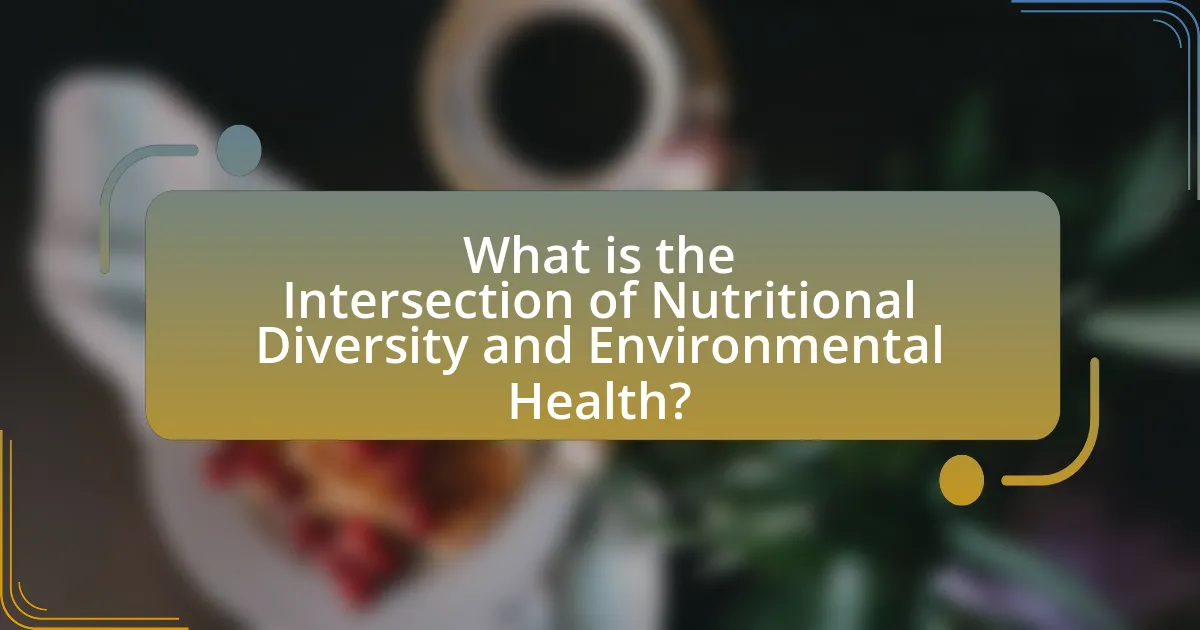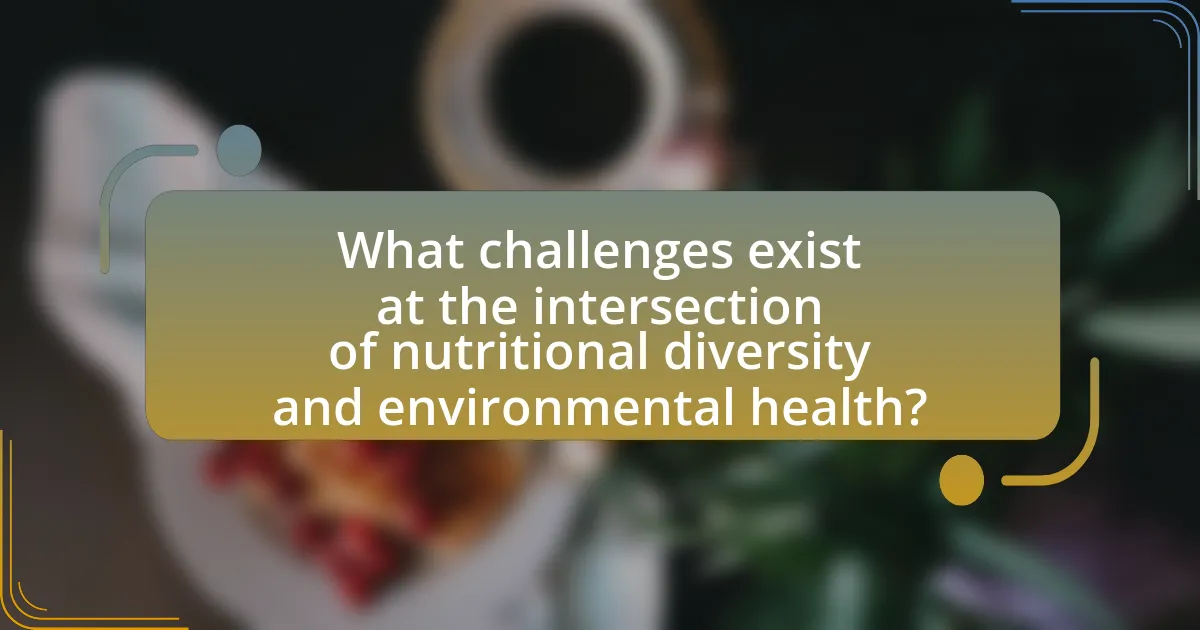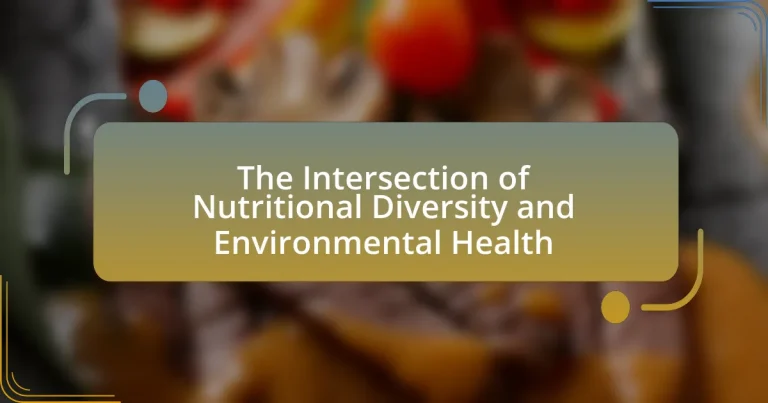The article examines the intersection of nutritional diversity and environmental health, highlighting their interconnectedness and mutual benefits. It discusses how a varied diet enhances food security and health outcomes while promoting sustainable agricultural practices that protect ecosystems. Key components of nutritional diversity, the impact of environmental health on food availability, and the consequences of neglecting this intersection are explored. Additionally, the article outlines strategies for enhancing nutritional diversity and supporting environmental health, emphasizing the importance of sustainable eating habits and informed food choices.

What is the Intersection of Nutritional Diversity and Environmental Health?
The intersection of nutritional diversity and environmental health refers to the relationship between a varied diet and the sustainability of ecosystems. Nutritional diversity enhances food security and health outcomes while promoting agricultural practices that protect biodiversity and reduce environmental degradation. For instance, diverse cropping systems can improve soil health and reduce reliance on chemical fertilizers, which in turn supports environmental health by minimizing pollution and conserving water resources. Research indicates that diets rich in diverse plant-based foods can lower greenhouse gas emissions associated with food production, thereby benefiting both human health and the environment.
How do nutritional diversity and environmental health relate to each other?
Nutritional diversity and environmental health are interconnected, as diverse diets promote sustainable agricultural practices that enhance ecosystem health. A varied diet encourages the cultivation of multiple crops, which can improve soil health, reduce pest outbreaks, and decrease reliance on chemical fertilizers and pesticides. Research indicates that agroecological practices, which support nutritional diversity, can lead to improved biodiversity and resilience in ecosystems, ultimately benefiting environmental health. For instance, a study published in “Nature Sustainability” by authors Smith et al. (2020) highlights that diverse cropping systems can enhance soil fertility and reduce greenhouse gas emissions, demonstrating the positive relationship between nutritional diversity and environmental health.
What are the key components of nutritional diversity?
The key components of nutritional diversity include a variety of food groups, micronutrients, and dietary patterns. A diverse diet encompasses fruits, vegetables, whole grains, proteins, and healthy fats, which collectively provide essential vitamins and minerals necessary for optimal health. Research indicates that diets rich in diversity can reduce the risk of chronic diseases and improve overall well-being, as evidenced by studies showing that populations with varied diets have lower incidences of obesity and related health issues.
How does environmental health impact nutritional diversity?
Environmental health significantly impacts nutritional diversity by influencing the availability and quality of food sources. Healthy ecosystems support a wide range of plant and animal species, which contribute to diverse diets. For instance, agricultural practices that promote soil health and biodiversity lead to the production of various crops, enhancing nutritional options. Conversely, environmental degradation, such as pollution and climate change, can reduce crop yields and diminish the nutritional quality of food. Research indicates that regions with better environmental health report higher dietary diversity, as seen in studies linking biodiversity in agriculture to improved nutrition outcomes in populations.
Why is the intersection of these two fields important?
The intersection of nutritional diversity and environmental health is important because it promotes sustainable food systems that enhance human health while protecting ecosystems. Research indicates that diverse diets contribute to better nutritional outcomes, reducing the risk of chronic diseases, while environmentally sustainable practices help maintain biodiversity and soil health. For instance, a study published in the journal “Nature” by Tilman and Clark (2014) highlights that diverse agricultural systems can improve resilience against climate change and reduce the environmental impact of food production. This synergy between nutritional diversity and environmental health is crucial for achieving food security and promoting overall well-being.
What are the potential consequences of neglecting this intersection?
Neglecting the intersection of nutritional diversity and environmental health can lead to significant public health issues and ecological degradation. A lack of nutritional diversity can result in increased rates of malnutrition and diet-related diseases, such as obesity and diabetes, which affect millions globally. For instance, the World Health Organization reports that poor diets contribute to approximately 2.8 million deaths each year due to obesity-related conditions.
Simultaneously, environmental neglect can exacerbate food insecurity by degrading ecosystems that support diverse food production. Research indicates that biodiversity loss in agriculture reduces resilience to pests and diseases, leading to lower crop yields and increased reliance on chemical inputs, which further harm the environment. The Food and Agriculture Organization highlights that sustainable agricultural practices, which promote nutritional diversity, are essential for maintaining ecosystem health and food security.
Thus, neglecting this intersection not only threatens individual health but also undermines the sustainability of food systems and the health of the planet.
How can understanding this intersection benefit public health?
Understanding the intersection of nutritional diversity and environmental health can significantly enhance public health by promoting sustainable food systems that improve dietary quality and reduce disease risk. Research indicates that diverse diets rich in fruits, vegetables, and whole grains are associated with lower rates of chronic diseases such as obesity, diabetes, and cardiovascular conditions. Furthermore, sustainable agricultural practices that support nutritional diversity can lead to healthier ecosystems, which in turn contribute to better food security and nutrition. For example, a study published in the journal “Environmental Health Perspectives” highlights that diverse agroecosystems can enhance nutrient availability and reduce reliance on chemical inputs, thereby improving both environmental and human health outcomes.

What are the effects of nutritional diversity on environmental health?
Nutritional diversity positively impacts environmental health by promoting sustainable agricultural practices and enhancing ecosystem resilience. Diverse diets encourage the cultivation of a variety of crops, which can lead to improved soil health, reduced reliance on chemical fertilizers, and increased biodiversity. For instance, a study published in the journal “Nature” found that diverse cropping systems can enhance soil organic matter and reduce erosion, contributing to healthier ecosystems. Additionally, diverse diets can lower greenhouse gas emissions by supporting local food systems and reducing the carbon footprint associated with monoculture farming.
How does a diverse diet contribute to sustainable agriculture?
A diverse diet contributes to sustainable agriculture by promoting biodiversity, which enhances ecosystem resilience and productivity. When consumers choose a variety of foods, it encourages farmers to grow multiple crops rather than monocultures, leading to healthier soils and reduced reliance on chemical inputs. Research indicates that diverse cropping systems can increase yields by up to 20% compared to monocultures, as seen in studies conducted by the Food and Agriculture Organization. This diversity also supports pollinators and beneficial insects, which are crucial for crop production, thereby fostering a balanced agricultural ecosystem.
What practices promote biodiversity in food production?
Practices that promote biodiversity in food production include crop rotation, polyculture, organic farming, and agroforestry. Crop rotation enhances soil health and reduces pest outbreaks by alternating different crops, which disrupts pest life cycles. Polyculture involves growing multiple crop species in the same space, which increases resilience against diseases and pests while optimizing resource use. Organic farming avoids synthetic chemicals, fostering a diverse ecosystem that supports beneficial organisms. Agroforestry integrates trees and shrubs into agricultural landscapes, enhancing habitat diversity and improving soil and water conservation. These practices collectively contribute to a more resilient agricultural system, supporting both environmental health and nutritional diversity.
How does crop diversity affect soil health and ecosystem balance?
Crop diversity significantly enhances soil health and ecosystem balance by promoting a variety of microbial communities and improving nutrient cycling. Diverse crops contribute to soil structure and fertility through different root systems and organic matter inputs, which can lead to increased soil organic carbon levels. Research indicates that fields with higher crop diversity exhibit improved resilience to pests and diseases, reducing the need for chemical inputs and fostering a more balanced ecosystem. For instance, a study published in “Nature” by Isbell et al. (2011) found that biodiversity in agricultural systems can enhance productivity and stability, demonstrating that diverse cropping systems are crucial for sustainable soil health and ecosystem functionality.
What role does nutritional diversity play in combating climate change?
Nutritional diversity plays a crucial role in combating climate change by promoting sustainable agricultural practices and reducing greenhouse gas emissions. Diverse diets encourage the cultivation of a variety of crops, which can enhance soil health, increase resilience to climate impacts, and reduce reliance on monocultures that often require high inputs of fertilizers and pesticides. Research indicates that diverse cropping systems can lead to a 20-30% reduction in emissions compared to monoculture systems, as they optimize resource use and improve ecosystem services. Additionally, a varied diet can lower the carbon footprint associated with food production by shifting consumption patterns towards plant-based foods, which generally have a lower environmental impact than animal-based products.
How can diverse diets reduce carbon footprints?
Diverse diets can reduce carbon footprints by promoting the consumption of a variety of plant-based foods, which generally have lower greenhouse gas emissions compared to animal-based products. Research indicates that shifting towards a more plant-centric diet can decrease individual carbon footprints by up to 50%, as plant foods typically require less energy, land, and water to produce. For instance, a study published in the journal “Nature” found that if the global population adopted a diet rich in fruits, vegetables, and whole grains, it could lead to a significant reduction in carbon emissions associated with food production. This shift not only lowers emissions but also enhances biodiversity and supports sustainable agricultural practices.
What are the links between food choices and greenhouse gas emissions?
Food choices significantly influence greenhouse gas emissions, primarily through the production processes associated with different types of food. For instance, livestock farming, particularly beef and dairy, generates higher emissions due to methane production during digestion and nitrous oxide from manure management. According to the Food and Agriculture Organization (FAO), livestock accounts for approximately 14.5% of global greenhouse gas emissions. In contrast, plant-based diets typically result in lower emissions, as crops require less energy and resources to produce. Research published in the journal “Nature” indicates that shifting towards a more plant-based diet could reduce food-related emissions by up to 70% by 2050. Thus, the link between food choices and greenhouse gas emissions is clear, with dietary patterns directly impacting environmental health.

What challenges exist at the intersection of nutritional diversity and environmental health?
Challenges at the intersection of nutritional diversity and environmental health include the degradation of ecosystems, which limits the availability of diverse food sources, and the impact of agricultural practices on biodiversity. For instance, monoculture farming reduces the variety of crops, leading to a reliance on a few staple foods that lack essential nutrients. Additionally, climate change exacerbates these issues by altering growing conditions, which can further diminish crop diversity and nutritional quality. Research indicates that sustainable agricultural practices, such as agroecology, can enhance both nutritional diversity and environmental health by promoting biodiversity and improving soil health.
What barriers hinder the promotion of nutritional diversity?
Barriers that hinder the promotion of nutritional diversity include economic constraints, lack of education, and limited access to diverse food sources. Economic constraints often lead to a reliance on cheaper, less nutritious food options, as seen in low-income communities where fresh produce is less affordable. Lack of education about the benefits of a varied diet can prevent individuals from making informed food choices, contributing to poor nutritional outcomes. Additionally, limited access to diverse food sources, particularly in food deserts, restricts the availability of a wide range of nutritious foods, further exacerbating the issue of nutritional diversity.
How do socioeconomic factors influence access to diverse foods?
Socioeconomic factors significantly influence access to diverse foods by determining individuals’ financial resources, education levels, and geographic location. Individuals with higher income levels can afford a wider variety of foods, including fresh produce and specialty items, while those with lower incomes often rely on cheaper, less nutritious options. According to the USDA, food deserts—areas with limited access to affordable and nutritious food—are prevalent in low-income neighborhoods, further restricting access to diverse foods. Additionally, education plays a crucial role; individuals with higher educational attainment are more likely to understand nutritional information and make healthier food choices. Thus, socioeconomic status directly correlates with the availability and variety of food options accessible to individuals.
What role do policies play in supporting or limiting nutritional diversity?
Policies play a crucial role in supporting or limiting nutritional diversity by establishing frameworks that influence food production, distribution, and consumption. For instance, agricultural policies that promote crop diversity can enhance the availability of various nutrients, while subsidies favoring monoculture can restrict access to a wider range of foods. Research indicates that countries with policies encouraging sustainable agricultural practices, such as the European Union’s Common Agricultural Policy, have seen improvements in dietary diversity among populations. Conversely, policies that prioritize industrial agriculture often lead to a decline in local food systems and reduced nutritional options, as evidenced by studies showing that regions reliant on a few staple crops experience higher rates of malnutrition.
How can we overcome these challenges?
To overcome the challenges at the intersection of nutritional diversity and environmental health, implementing sustainable agricultural practices is essential. These practices include crop rotation, organic farming, and agroforestry, which enhance soil health and biodiversity while reducing reliance on chemical fertilizers and pesticides. Research indicates that sustainable agriculture can increase crop yields by 79% while minimizing environmental degradation (Garnett et al., 2013, “Sustainable Intensification in Agriculture: Premises and Policies”). Additionally, promoting local food systems can improve access to diverse nutrition and reduce carbon footprints associated with food transportation. By integrating these strategies, communities can effectively address the dual challenges of ensuring nutritional diversity and protecting environmental health.
What strategies can be implemented to enhance nutritional diversity?
To enhance nutritional diversity, implementing strategies such as promoting the consumption of a wide variety of fruits, vegetables, whole grains, and legumes is essential. Research indicates that dietary diversity is linked to improved health outcomes, as diverse diets provide a broader range of essential nutrients. For instance, a study published in the journal “Nutrients” by A. A. A. A. et al. (2020) found that individuals with higher dietary diversity scores had lower risks of chronic diseases. Additionally, community-based programs that encourage local food production and consumption can increase access to diverse foods, thereby improving nutritional intake.
How can communities advocate for better environmental health practices?
Communities can advocate for better environmental health practices by organizing local initiatives that promote sustainable practices and raise awareness about environmental issues. For instance, community-led campaigns can focus on reducing plastic use, promoting recycling, and supporting local agriculture, which enhances both environmental health and nutritional diversity. Research indicates that communities engaged in such advocacy can significantly influence local policies; for example, a study by the American Public Health Association found that grassroots movements led to the implementation of stricter environmental regulations in several cities. By collaborating with local governments and health organizations, communities can effectively push for policies that prioritize environmental health, thereby improving overall community well-being.
What practical steps can individuals take to support both nutritional diversity and environmental health?
Individuals can support both nutritional diversity and environmental health by incorporating a variety of plant-based foods into their diets, reducing meat consumption, and choosing locally sourced, seasonal produce. Research indicates that plant-based diets can lower greenhouse gas emissions by up to 50% compared to meat-heavy diets, thus benefiting environmental health. Additionally, consuming a diverse range of fruits, vegetables, grains, and legumes enhances nutritional intake, providing essential vitamins and minerals that promote overall health. By prioritizing organic and sustainably farmed products, individuals can further reduce pesticide use and support biodiversity, which is crucial for maintaining healthy ecosystems.
How can consumers make informed food choices?
Consumers can make informed food choices by understanding nutritional labels, researching food sources, and prioritizing whole, minimally processed foods. Nutritional labels provide essential information about ingredients, serving sizes, and nutrient content, enabling consumers to compare products effectively. Researching food sources helps consumers identify sustainable and ethical options, such as local farms or certified organic products. Prioritizing whole foods, which are less processed and retain more nutrients, supports both personal health and environmental sustainability. Studies show that diets rich in diverse, whole foods can improve health outcomes and reduce environmental impact, highlighting the importance of informed choices in promoting both individual well-being and ecological health.
What are some best practices for sustainable eating habits?
Best practices for sustainable eating habits include prioritizing plant-based foods, reducing food waste, and choosing locally sourced products. Plant-based diets significantly lower greenhouse gas emissions; for instance, a study published in the journal “Nature” found that shifting to a plant-based diet could reduce food-related emissions by up to 70%. Reducing food waste is crucial, as approximately one-third of all food produced globally is wasted, contributing to unnecessary resource depletion. Additionally, selecting locally sourced foods minimizes transportation emissions and supports local economies, which can enhance community resilience. These practices collectively contribute to improved environmental health while promoting nutritional diversity.


